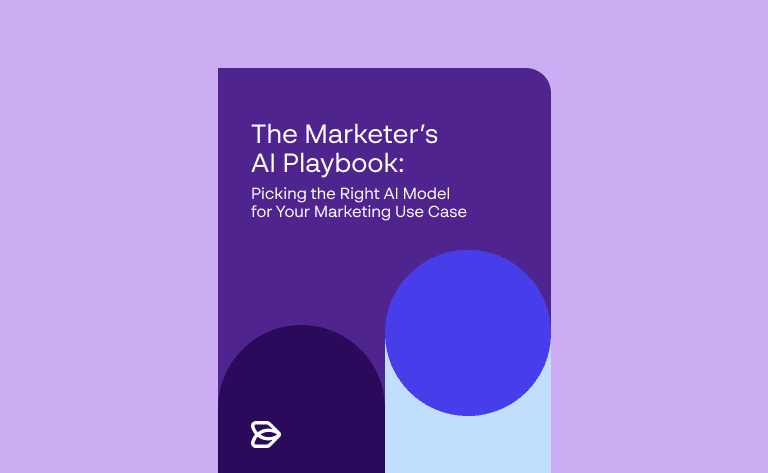This content has been automatically translated and may include minor variations.
AI is no longer a future trend – it’s the defining force in marketing today. The gap between AI-powered marketing teams and traditional approaches is widening faster than anyone predicted. Yet amid the hype, one question matters most for marketers: are you using the right AI tools for the job?
Our comprehensive analysis of 15 leading AI models uncovers a clear divide. Some marketing teams are unlocking exponential gains with strategic, affordable tools. Others are overpaying for underperformance. The difference isn’t budget – it’s alignment between model and use case.
Why marketers are overpaying for AI tools with little return
What shocked us most? Price. Some AI solutions cost 1,500 times more than others – with little justification in outcome. When it came to generative performance and task execution, cost rarely correlated with quality.
Marketing teams are overpaying by thousands while others achieve similar results for under $50 monthly.
One standout – Manus AI. Operating as a fully autonomous marketing agent, It practically executes end-to-end campaigns while you sleep, with minimal human intervention. No other solution comes close to its capabilities.
What you need to know about choosing AI tools for marketers
- AI marketing automation is real—and already delivering results
AI agents can now plan, produce, and optimize content around the clock. Teams using these tools report up to 300% increases in output without increasing headcount.
- When matched to the right task, mid-range AI tools win
Mid-tier tools in the $200–$500/month range outperformed high-cost options when matched to specific tasks like social media copywriting, email sequencing, and performance analytics.
- How combining AI tools leads to better marketing outcomes
Top-performing teams combine tools – one for content generation, another for data analysis, another for workflow automation. It’s this modular approach that delivers scale and precision.
Clarify who needs to approve each asset, brief them early, and build your timelines around that reality. A tech solution with built-in approval workflows can also help manage this complexity. Assign reviewers, set deadlines, and trigger automated notifications so that everyone knows what to expect and when. Having full visibility into the status of each task also prevents bottlenecks from going unnoticed until it’s too late.
What CMOs need to know before investing in AI for marketing
Our research identified AI tools tailored to each major marketing function – from $0.10 per million token solutions ideal for high-volume content, to $199/month autonomous agents that can run entire campaigns.
We’ve mapped which tools perform best across content marketing, social media, email campaigns, paid advertising, and analytics – and provided budget-specific recommendations for startups, mid-market, and enterprise teams.
The bottom line – AI isn’t just changing the way marketing works. It’s redrawing the competitive landscape. The question is whether you’ll lead the shift – or be overtaken by it?
What’s inside the full comparison guide
Our Marketer’s AI Playbook is a must-read for teams evaluating AI solutions. It includes:
- Benchmarks for 15 top LLMs across speed, quality, and cost
- Clear use case recommendations for content marketing, paid media, analytics, and workflow automation
- Comparisons between generalist tools and specialized AI marketing tools
- Budget frameworks for startups, mid-market, and enterprise teams
We’ve made this resource actionable. Whether you’re looking to test AI-generated content, automate campaign optimization, or build a scalable AI stack – this guide shows you where to start.
Download the full guide to see which AI models fit your marketing strategy – and which to avoid.
How AI tools for marketers are reshaping the competitive landscape
Strategic marketers are no longer experimenting with AI – they’re scaling it. The brands gaining ground aren’t necessarily larger. They’re faster, more focused, and more data-informed.
AI isn’t just disrupting how we work. It’s redrawing the competitive landscape. The next wave of winners will be defined not by budget – but by how well they match the right model to the right moment.
Where possible, bring these processes into one place. Whether through a single point of contact or a centralized management platform, reducing the number of separate touchpoints can save hours — and minimize the chances of important details falling through the cracks. It also simplifies finance and procurement, making it easier to track spending, approvals, and post-event reporting.
Find the right AI model for your team
Compare 15 tools by cost, output, and use case fit.


FAQs
Q: What are the best AI tools for marketing teams?
A: The best AI tools vary based on your needs — some excel at content generation, others at data analysis or campaign automation. The key is matching tools to specific tasks, not just chasing the biggest names.
Q: Is expensive AI software always better?
A: No — Papirfly’s research shows that mid-priced AI tools often outperform high-cost solutions when aligned with specific marketing use cases. Quality doesn’t always scale with price.
Q: Can AI tools fully automate marketing campaigns?
A: Yes — some AI agents can now handle planning, execution, and optimization with minimal input. However, most teams benefit from combining automation with strategic oversight.
Q: How should marketers build their AI tech stack?
A: The most effective teams use a modular approach — selecting different tools for content creation, analytics, and workflow. Consolidate where you can, but avoid overreliance on one platform.
Q: Where can I find a comparison of top AI marketing tools?
A: Download Papirfly’s The Marketer’s AI Playbook for benchmarks across 15 AI models, including pricing, performance, and recommendations tailored to your budget and goals.



